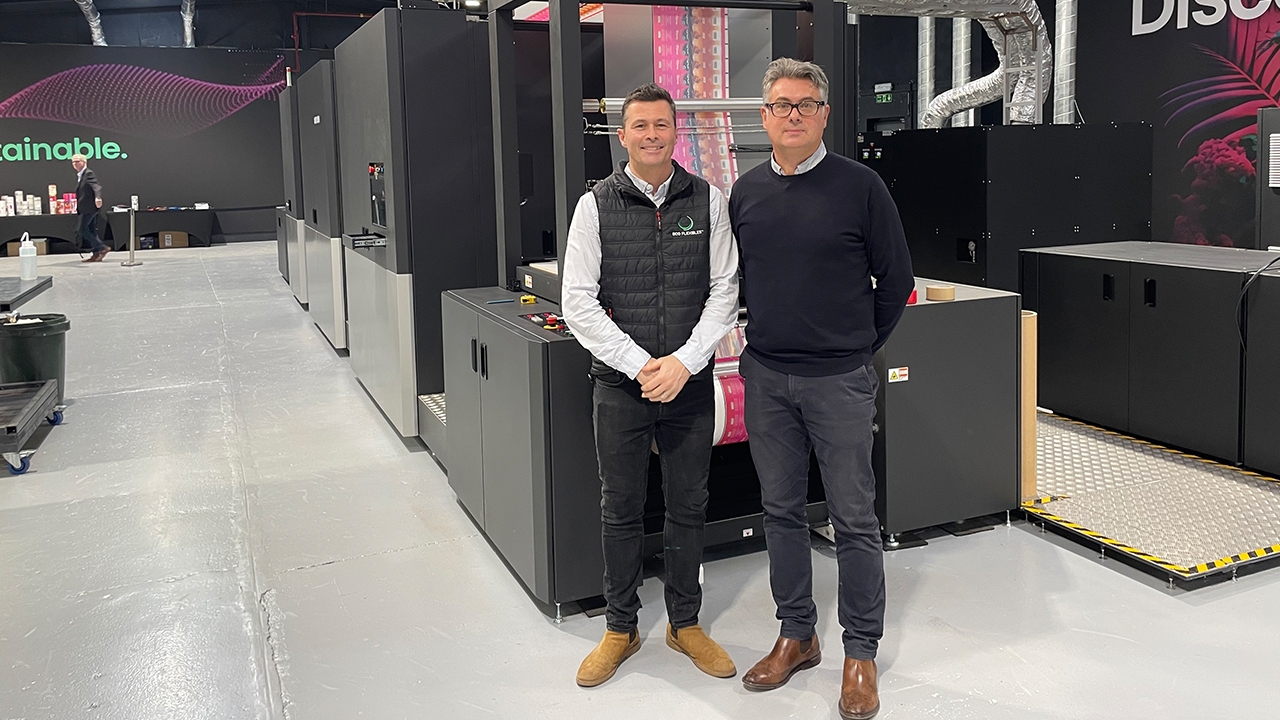The internet of labels

Over two days in early March, the seminar combined networking and exploring, and evaluated the ‘challenges in the label market’ that constituted the event’s chosen agenda.
Exploring the clouds
The seminar’s keynote speaker, Andy Hobsbawm, co-founder and CMO of IoT smart products platform Evrythng, set the tone for the event by discussing the way in which the Internet of Things and its key advantage – data – have enabled smart products to transform brand relationships, customer interactions, product authentication and brand security, business management and service experiences. It is currently in its infancy but growing fast – particularly in such areas as serialization and on-pack augmented reality devices. In fact, said Hobsbawm: ‘99 percent of things will become part of a connected network.’
The benefit of on-pack communicators for brand owners is, of course, the huge source of data received as a result. It can deliver end-to-end visibility across a product’s lifecycle, enhance business efficiency and help to secure the supply chain Hobsbawm adjured seminar participants to actively exploit these opportunities and ‘transform your products into smart digital assets’.
As if in answer to this plea, Günther Dieroff, sales and marketing manager at Swedish label printer Beneli, which already has an established reputation in smart labels, went on to discuss in detail the sheer scope of the customer engagement market, which is ‘everywhere from childhood to retirement’, particularly in partnership with mobile devices. Dieroff led the audience along the NFC digital corridors that can deliver successful business results for brands and retailers, as well as successful purchasing and brand engagement for consumers. On-pack promotions and invitations to connect with a product are creating increased consumer engagement, particularly when compared with traditional standard advertising and promotional activities. However, he said, QR codes are not the route to follow. ‘Only 155 of smart device users know how to scan properly,’ he said, adding: ‘They are ugly.’. He went on to show that there are plenty of other creative communication options for NFC scanning.
Do things differently
The complex business of making ready the production process is today much simplified and quickened by the linking of front end activities via digital workflows, as Xeikon’s director of product management, Jeroen van Bauwel, showed. Particularly in the light of today’s customer demands for shorter print runs and shorter lead times, ‘make-ready time becomes a major bottleneck,’ he explained.
Digitizing the production process can, he showed, not only reduce the costs of print job preparation, pre-press and manufacturing time, by over 20 percent in some cases, but also creates additional production capacity, reduces on-press waste and can improve all-round quality. A ‘no paper’ workflow from order entry to invoicing is a prime benefit of digital production, coupled with optimized color management; substrate standardization and order grouping based on substrate; plus the addition of ‘separator labels’ for better integration with on-press finishing systems.
The principles of workflow automation were then addressed in depth by Geert de Proost, director of solutions marketing at Esko, who described his paper as automation myths debunked. In a world where speed to market is the desire of product manufacturers and their customers alike, great packaging is also a key requirement. There is one way that the label converter can make this dream come true, said de Proost: ‘Digitize, automate, connect.’
He detailed the ways in which production can be streamlined, so that label converters can better meet the requirements of their brand owner customers, and enjoy benefits across the production process, without compromise.
‘All of a sudden, your bottleneck is not the printing machine,’ continued Daragh Whelan, process manager at Bobst, who discussed digital automation for flexography in the face of the challenges in the label market from digital print.
Bobst is a member of the Revo partnership formed with other industry suppliers to provide viable full-circle digital flexo. Whelan showed how, with digital UV flexo, the Revo option delivers wide graphic flexibility in terms of extended color gamut technology. It also offers significant improvements over conventional flexo in terms of both minimal process waste and make-ready time, reduced from a total of three hours for conventional flexo to just 10 minutes with digital flexo.
Accept, create, invest
Marjolein Ekkelboom, MPS Systems’ global marketing manager, was uncompromising in telling seminar participants to ‘accept, create, invest’ in the benefits of connectivity. The hardware and software are ready, as prior speakers had shown, and can deliver multiple core business rewards in terms of a successful business future. Indeed, she underlined that revenue generated from IoT and ‘Big Data’ services are set to exceed €300 billion (US$366 billion) by 2020 – and that is just the beginning.
Interactive troubleshooting workshops
The afternoon session consisted of a choice of two parallel interactive troubleshooting workshops for delegates, on key current label converting scenarios, which were moderated by De Ruyter Strategy. John Hammond, sales director at Nilpeter UK, led the workshop on self-adhesive multi-layer peel-and-read labels and their construction, which provoked lively participant interest. As a result of increasingly-strict regulatory requirements in terms of the provision of more in-depth product information in the field of pharmaceuticals and OTC medicines, as well as a general desire to place just ‘one label’ on a product, peel-and-read labels now represent a strong opportunity arena for label converters because, He summed up: ‘You just took away all the brand owners’ problems with a single solution.’ He explained in depth both the single- and dual-web production options, and concluded that one-pass production of peel-and-read labels would additionally give label converters ‘the opportunity to bring that advantage to the market’.
‘It makes sense’
Nanette Thomas, founder and CEO of Synthogra, led a very lively and positive workshop on ‘going into flexible packaging and sleeves’ on narrow web presses, alongside traditional self-adhesive labels. She encouraged participants to look at the process of starting up such a process – including the practical production challenges and pitfalls, brand owners’ buying behavior, and the implications of food safety regulations. As she showed, for label converters today, flexible packaging and sleeve label production represent a genuine opportunity to gain additional market share with existing brand owner customers, as well as resultant increased profitability.
As moderator Paul de Ruijter commented: ‘Flexible packaging is very important for the label industry in terms of increasing its role with the brand owners, and it can really raise the bar for the industry, taking it from secondary packaging print into the realms of primary packaging production.’ Finat’s role in enabling such industry evolution is of course key, he underlined.
Inks and surface decoration
On the morning of the second day, inks and decoration were the focus of the presentations. Opening the program, Bo Meyer of UEI Falcontec looked at non-ink-based label surface enhancement in the form of hot or cold foiling, embossing or texturing. This is today a popular choice for adding on-shelf value to labels on consumer products such as wines, he said, as well as for micro-embossing in product security/authentication applications. He laid out the technical parameters for hot foiling – including controlling heat dwell time, pressure, temperature, machine speed and heat conduction in the foiling tool – and for cold foiling, primarily featuring metallized foils, which may be overprinted to achieve the required color.
Then it was the turn of Dr Heinz Schweiger of Zeller+Gmelin to talk about the way in which, in label converting, the issue of ink migration into foods from labels and packaging can be addressed. He showed how the company’s proprietary DirectCure curing technology for special UV inks employing a reduced number of photoinitiators can cost-effectively replace EB curing in such applications.
Sun Chemicals’ Jonathan Sexton explored the characteristics of all the key ink drying methods in use today, with a particular focus on UV and EB curing. ‘The substrate isn’t really important,’ he stated, but emphasized that the choice of a drying system must satisfy multiple criteria for both analogue and digital print, if optimal results in process optimization and final print quality are to be achieved. ‘Talk to your suppliers,’ he urged delegates.
It was then time to look at varnishes, which perform a variety of functions, from surface protection to the visual enhancement of print. Volker Michel of Pulse Roll Label Products discussed their chemistry, manufacture and applications. He looked at overcoming common challenges, including the requirements of digital print; special finishes such as rough texture; print-to-cure dwell times; and possible contamination of the cationic systems used for peel-and-read labels. The key to a successful end result is, he said, collaboration between ink and varnish supplier, anilox supplier, repro company and printer to identify the right formulation.
Raymond Lu, general manager at Dragon Foils, China, delved deeply into the subject of cold foils, of which his company is a major supplier. He discussed the structure, technology, application methods and currently-active markets for cold foil decoration, which offers time and energy savings over hot foiling, although with a reduced color intensity. Now used extensively around the world, the technology also now features leading-edge, highly-cost-effective digital printing foils; colored foils; registered lens foiling on packaging; and a variety of holographic patterns.
Label facestocks
Coated facestock media used with water-based inkjet printing for demanding end-use applications such as tire labels and chemical drum labels to BS5609 were discussed by Sihl’s Dr Axel Niemöller. Choosing the appropriate inks and media are, as ever, key to success. The print substrate must, he emphasized, feature an inkjet-receptive surface, primarily film-based, and take full account of the label’s end use in terms of print key effectiveness, abrasion resistance and print permanence.
Dr Anil Gaikwad, head of R&D at Indian film manufacturer Cosmo Films analyzed his company’s BOPP label films range, detailing their specific properties, manufacture and suitable label applications. The range includes white cavitated films, high-clarity transparent films and synthetic papers; and also high-gloss metallized films, both single-coated and two-sides-coated, as a replacement for metallized paper substrates.
In the last formal seminar presentation, Finat president Chris Ellison, managing director at OPM (Label & Packaging) Group in the UK, studied the challenges and pitfalls of choosing an MIS supplier, and provided an in-depth user’s guide to choosing, installing and implementing an MIS system that is appropriate for the label industry supply and service chain.
‘An end-to-end system, this is the way to go,’ he confirmed from personal experience, adding that, while systems are great, ‘people like people – and our customers like to talk to us.’
Stay up to date
Subscribe to the free Label News newsletter and receive the latest content every week. We'll never share your email address.

